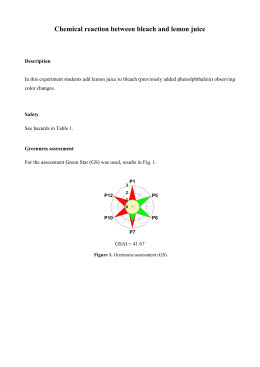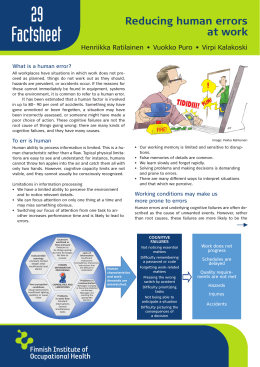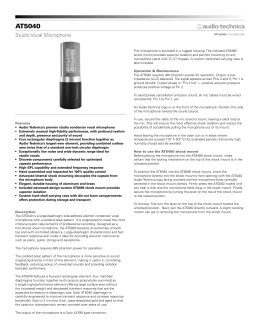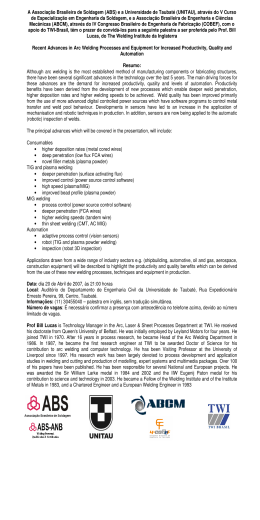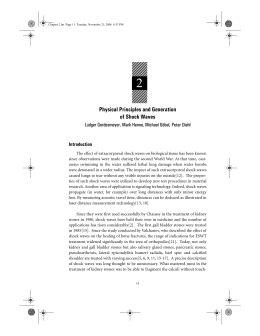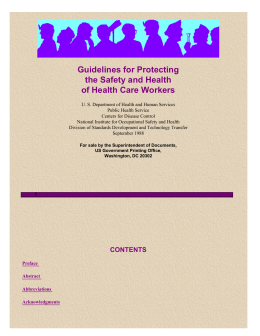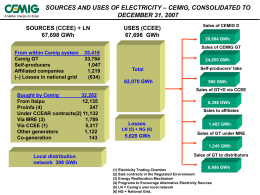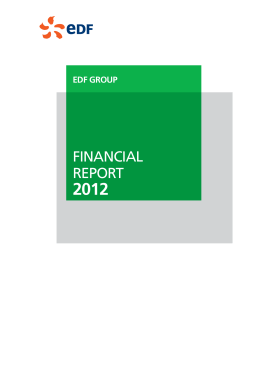Common Sense and Knowledge Approach to Electrical Safety L. Bruce McClung Distinguished Lecturer on Electrical Safety Issues for IEEE-IAS/PES 2002-03 3/30/2004 1 For IEEE-Brazil Section in Guararema - Sao Paulo, Brazil October 21, 2003 and in Rio de Janeiro, Brazil October 23, 2003 3/30/2004 2 Electricity Benefits Mankind 3/30/2004 Most people use electricity only for lighting and heating, etc. Familiarity with electricity is accepted as normal. Hazards posed by electricity are overlooked. 3 Electricity Presents Hazards Employees are exposed to the following: • • • • 3/30/2004 Electrocution Electric shocks Arc-flash burns Pressure wave 4 Electricity Presents Hazards (cont’d) • • • 3/30/2004 Flying debris—shrapnel Expanding vapor cloud Explosions of flammable gases, vapors, or combustible dusts 5 Static Electricity—Examples 1—Static electricity begins when two dry surfaces in intimate contact are separated. Motion (slide/glide) over an insulating surface, such as a carpet or automobile seat, draws electrons to the surface, creating a charge that “zaps” a person as he/she reaches for a door knob. 3/30/2004 6 Static Electricity—Examples (cont’d) 2—Dry air or dry particles move over or through dry surfaces that are isolated or partially separated from earth. The dry surfaces usually accumulate a charge that increases enough to finally result in a discharge to earth (lightning). 3/30/2004 7 Electrocution Statistics (1999) Electrocutions accounted for almost 5 percent of all on-the-job fatalities. 278 people were electrocuted at work. All of these fatalities could have been avoided. 3/30/2004 8 Electrical Safety Standards Standards minimize dangers in the workplace. 3/30/2004 Installation standards Equipment and appliance or component standards Workplace standards 9 Physics of Electricity Flow of electricity is governed by the following: 3/30/2004 Conductors offer little resistance to flow of current. Metals generally make good conductors. Earth, particularly if moist, is a conductor. 10 Physics of Electricity (cont’d) 3/30/2004 Insulators confine current flow to desired pathways. Porcelain and plastic make good insulators. Air, normally a good insulator, becomes conductive when saturated with humidity. 11 Physics of Electricity (cont’d) 3/30/2004 Pure water is a poor conductor. Dry wood is a poor conductor. Impurities in water, such as salt, solvents, etc., can make water and moisture-saturated wood conductive. Skin has high resistance compared to an efficient conductor. 12 Physics of Electricity (cont’d) 3/30/2004 When moist or wet, from perspiration or contaminated water, skin acts as a conductor. Remember—air, normally a good insulator, becomes conductive when saturated with humidity. 13 Electrical Installations New electrical equipment installed according to recognized and accepted codes and standards is considered to be safe. Problems occur when the following happen: 3/30/2004 Deterioration occurs to enclosures, conductors, and insulation. Workers perform unsafe/careless acts. 14 Electrical Accidents/Incidents 3/30/2004 A person receives an electrical shock when the body mistakenly becomes part of the electrical circuit. Electrical shock occurs when current flows through the body from contact with two energized conductors or from contact with one energized conductor and earth. 15 Electrical Accidents/Incidents (cont’d) Current normally flows in a known closed circuit. When an electrical fault occurs, as when a conductive object causes a short-circuit, the current begins to flow in an unknown circuit, as from a conductor to ground or another conductor. 3/30/2004 16 Effects of Electrical Current on the Human Body Current Reaction Below 1 mA 1 mA 5 mA Not perceptible Faint tingle Slight shock (Not painful) Painful shock, loss of muscle control Individual cannot let go Respiratory arrest 6-25 mA 9-30 mA 50-150 mA 3/30/2004 17 Effects of Electrical Current on the Human Body (Cont’d) Current Reaction 1,000-4,300 ma Rhythmic pumping Action of heart ceases Cardiac arrest-burns 10,000 ma 3/30/2004 18 Effects of Electrical Shock on the Human Body The effects depend upon the following: 3/30/2004 The amount of current The path of the current The length of time the body remains in contact with the circuit The frequency of the current 19 Effects of Electrical Shock on the Human Body (cont’d) Muscular contractions “freeze” the body – when the amount of current flowing through the body reaches level at which person cannot let go – increases length of exposure (cont’d) 3/30/2004 20 Effects of Electrical Shock on the Human Body (cont’d) – current flow causes blisters, reduces surface resistance to current flow, increases current flow, causes severe injury or death 3/30/2004 21 Effects of Electrical Shock on the Human Body (cont’d) 3/30/2004 Extensor muscles “fling” the body “Jerk” reaction results in falls, cuts, bruises, bone fractures, and even death 22 Help for a Victim “Frozen” on a Conductor 3/30/2004 Shut off circuit immediately and call for help. Use non-conducting materials to push or pull the victim away from contact with energized conductor— be sure not to contact victim with your bare hands or any conductive material. 23 Help for a Victim of Electrical Shock The severity of electrical shock is difficult for non-medical personnel to analyze, as invisible (internal) damage can occur. 3/30/2004 Seek emergency medical help immediately Follow-up evaluation is often required 24 Electrical Burns 3/30/2004 A person receives a second-degree burn when he/she is near an electrical arc in which the incident energy level is above the threshold of 1.2 cal/cm2 or 5.0 J/ cm2. Burn injuries are more common than electrical shock injuries. 25 Arc Flash Burn Hazard Temperature and Heat Data Temperature Curable burn Cell death Temperature of sun’s surface Temperature at arc terminals Temperature of clothing ignition Temperature of burning clothing 3/30/2004 145° F 205° F 9,000° F 35,000° F 700° F – 1,400° F 1,400° F 26 Effects of Burns on the Body 3/30/2004 Electrical burns occur when enough current flows through tissue or bone to generate damaging heat. Arc or flash burns occur when high-level incident energy emanates from an electric arc near the body. Thermal contact burns occur when clothing ignites from high-level incident energy or when the skin touches hot surfaces of overheated electric conductors or circuit parts. 27 Other Electrical Hazards In addition to electrical shock and burns, the following may occur: 3/30/2004 Arcs can start fires. High-energy arcs can damage equipment. Low-energy arcs can cause explosions of flammable atmospheres. 28 Protecting against Electrical Hazards 3/30/2004 Assign a site Electrical Safety Committee. Develop an Electrical Safety Program. Maintain electrical equipment in “as-new condition.” 29 Protecting against Electrical Hazards (cont’d) 3/30/2004 Maintain a safe work environment. Avoid unsafe/careless acts. Plan for the unexpected. Communicate / Warn / Guard. 30 Protecting against Electrical Hazards (cont’d) Assign a site Electrical Safety Committee 3/30/2004 Electrical engineer Electrical supervisor Electrician Safety professional Consultant 31 Protecting against Electrical Hazards (cont’d) Develop an Electrical Safety Program to include the “Ps.” Don’t forget the “Purpose.” Policy Principles Procedures Permanent records PPE 3/30/2004 Program manager Philosophy Practices Performance Personnel Participants 32 Protecting against Electrical Hazards (cont’d) Maintain electrical equipment in “as-new” condition. Have an electrical equipment integrity plan. 3/30/2004 Inspect Test Trend Repair / replace 33 Protecting against Electrical Hazards (cont’d) Maintain a safe work environment. 3/30/2004 Keep electrical working spaces clear. Have electrical system information at hand. Place appropriate identification on all equipment. Plan every job and work the plan. 34 Protecting against Electrical Hazards (cont’d) Avoid unsafe/careless acts. 3/30/2004 Allow only qualified employees to work on energized equipment. Have an “evergreen” electrical safety program. Perform a hazard risk analysis before beginning a task. 35 Protecting against Electrical Hazards (cont’d) Plan for the unexpected. 3/30/2004 Avoid potential hazards, wherever possible. Minimize unavoidable hazards. Control / contain the hazards that remain. 36 Protecting against Electrical Hazards (cont’d) Communicate / Warn / Guard. 3/30/2004 Study and label the system function and the equipment operation. Train in the electrical safety program. Identify / label arc flash hazards. Forbid entry to unauthorized persons. 37 Protecting against Electrical Hazards (cont’d) Communicate / Warn / Guard (cont’d.). 3/30/2004 Enclose or locate electrical equipment so people don’t accidentally contact energized parts. Post a temporary standby person while work is in progress, if necessary. 38 Protecting against Electrical Hazards (cont’d) Adhere to a hierarchy of electrical safe work practices. 3/30/2004 De-energize before working on or near exposed electrical conductors or circuit parts. If de-energizing is infeasible, then obtain signature of person-in-charge to validate need for energized work. 39 Protecting against Electrical Hazards (cont’d) Adhere to a hierarchy of electrical safe work practices (cont’d). 3/30/2004 If a worker must enter closer than the arc flash boundary, then ensure that the person wears appropriate personal protective equipment (PPE), including properly rated rubber insulating gloves, meters, and tools. 40 Protecting against Electrical Hazards (cont’d) Know your limits. Use “My Electrical Safety Principles”: 3/30/2004 Plan every job. Anticipate unexpected events. Use the right tool for the job. Use procedures as tools. Isolate the equipment. 41 Protecting against Electrical Hazards (cont’d) “My Electrical Safety Principles” (cont’d): 3/30/2004 Identify the hazard. Minimize the hazard. Protect the person. Assess people’s abilities. Audit these principles. 42 Protecting against Electrical Hazards (cont’d) Know your grounding. 3/30/2004 Intentionally create a low-resistance path that bonds to earth an electrical system or a conductive enclosure of a tool, machine, or equipment. Use a system ground to limit overvoltage during abnormal conditions. 43 Protecting against Electrical Hazards (cont’d) Know your grounding (cont’d). 3/30/2004 Provide an equipment ground as an alternate path for current to pass from the tool, machine, or equipment to ground, in event of a malfunction that causes its conductive enclosure to become energized. 44 Protecting against Electrical Hazards (cont’d) Know your grounding (cont’d). 3/30/2004 Understand that a “safety ground” is installed following de-energizing and LO/TO between the source(s) of electrical power and the location where repair/replacement work will be performed. 45 Protecting against Electrical Hazards (cont’d) Know your grounding (cont’d). 3/30/2004 “Safety grounds” (conductors and attachments) must be rated to safely carry the total short-circuit current available at the site where they are installed for the duration of time it takes the protective devices to clear the faulted circuit. 46 Protecting against Electrical Hazards (cont’d) Know your arc-flash hazards. 3/30/2004 Perform an arc flash hazard analysis to determine the arc flash protection boundary and the incident energy at the working distance from potential arc sources for every piece of electrical equipment that operates above 50V. 47 Protecting against Electrical Hazards (cont’d) Know your arc-flash hazards (cont’d). 3/30/2004 Use PPC&E that is appropriately matched by its arc thermal performance value to the incident energy available at the work site. Ensure careful consideration and obtain high-level site management authorization any time energized work must be performed. 48 “Common Sense and Knowledge Approach to Electrical Safety” October 21,2003 TOPICS “Common Sense and Knowledge Approach to Electrical Safety” deals with the elementary physics of electrical shock and arc flash hazards. The potential adverse affects of these electrical hazards on people and equipment are explained. The need for a site and/or corporate Electrical Safety Committee is reviewed. The process of developing an Electrical Safety Program and training in its contents is covered. Electrical safe work practices, such as “job briefings”, and electrical safety procedures, such as lockout/tagout, to avoid the hazards associated with working on or near energized electrical conductors or circuit parts are presented. The heiarchy of establishing an “Electrical Safe Work Condition is emphasized. The role of maintenance to enhance electrical safety is included. Finally the benefits of matching and using personal protective clothing/personal protective equipment to the potential arc flash hazard and voltage level at the work place is included. “Electrical Safety by Design” October 22, 2003. “Electrical Safety by Design” is strongly emphasized in the new IEEE 1584-2002 “Guide for Performing Arc-Flash Hazard Calculations”. How to perform an arc flash hazard analysis will be explained. Its results are used to apply electrical system concepts and electrical equipment features to minimize the adverse effects of electrical shock and electrical arc flash. It states “Safety by design measures should be actively considered during the design of electrical installation to improve personnel safety. For example, properly tested and installed arc resistant switchgear (see IEEE C37.20.7-2001 or IEC ) can provide safety for operating personnel, while the doors are secured. Remote control and remote racking are also examples of methods to improve safety by design. Similarly, providing suitable and readily accessible disconnecting means separate from equipment to be worked upon will enable isolation and deenergization. Engineering designs can also specify the appropriate system design, equipment, protection, etc., to minimize fault current magnitude and duration. Changing protection settings can reduce the fault current. It is also possible to consider alternate work practices that provide increased work distances.” Employees must be protected from electrical shock and arc flash burns either by design and engineering controls, or by work procedures, and/or other necessary protective measures. Electrical safety features should be designed and incorporated in equipment to protect personnel from making contact with exposed energized electrical conductors and circuit parts, as well as protecting them from any electrical arc flash hazards. SPEAKER L. Bruce McClung, IEEE Fellow, retired from Union Carbide Corporation (UCC), now Principal Consultant with Electrical Safety Consulting Services, Inc. He joined UCC in 1960 and In 1997 he became the first electrical engineer to be named a Corporate Fellow there. Widely respected as a technical leader in the application of electric power systems on an industrial scale, Mr. McClung has provided electrical technology support for the design, construction, operation and maintenance of large chemical and plastic plants. His work in advancing technology, standards, and work practices has dramatically improved electrical safety. Safety-enhancement technologies he helped to develop include high-resistance grounding, arc-resistant switchgear, zero-halogen insulating compounds for wire and cable, and thermal protective clothing. Mr. McClung presently serves IEEE as a member of the Standards Association Board of Directors and as the Distinguished Lecturer on Electrical Safety Issues for IAS/PES 2002-2003. Mr. McClung has authored or co-authored 28 technical papers, 18 of which have made IEEE-IAS Transactions Status, while 9 earned IEEE-IAS prize paper awards. He received the IEEE Standards Medallion, the IEEE Charles Proteus Steinmetz Award, the 2000 PCIC Electrical Safety Excellence Award, the 2001 IEEE Medal for Engineering Excellence and the 2001 IAS Outstanding Achievement Award. He also received Union Carbide’s Chairman’s Award, and has been elected a member of West Virginia University Academy of Electrical and Computer Engineers. He is a Registered Professional Engineer in the State of West Virginia.
Download
